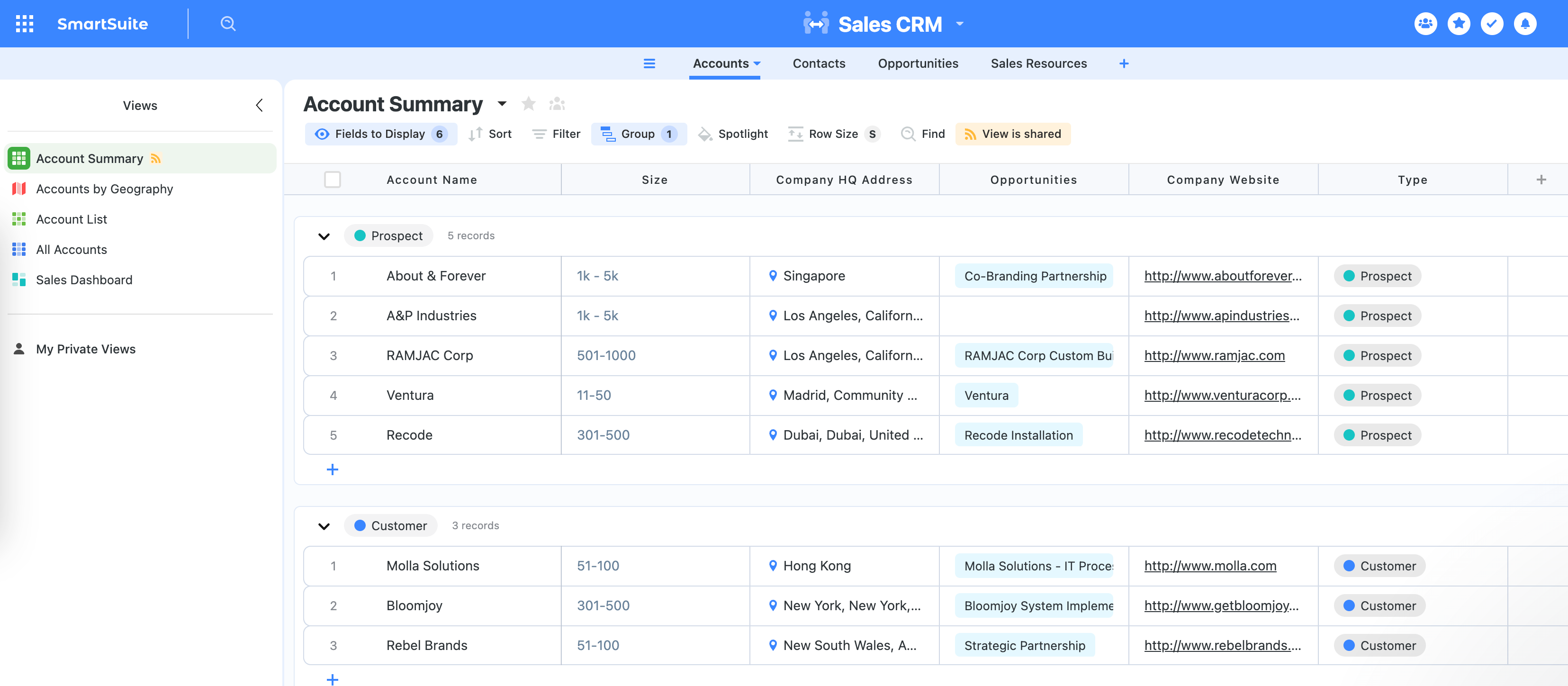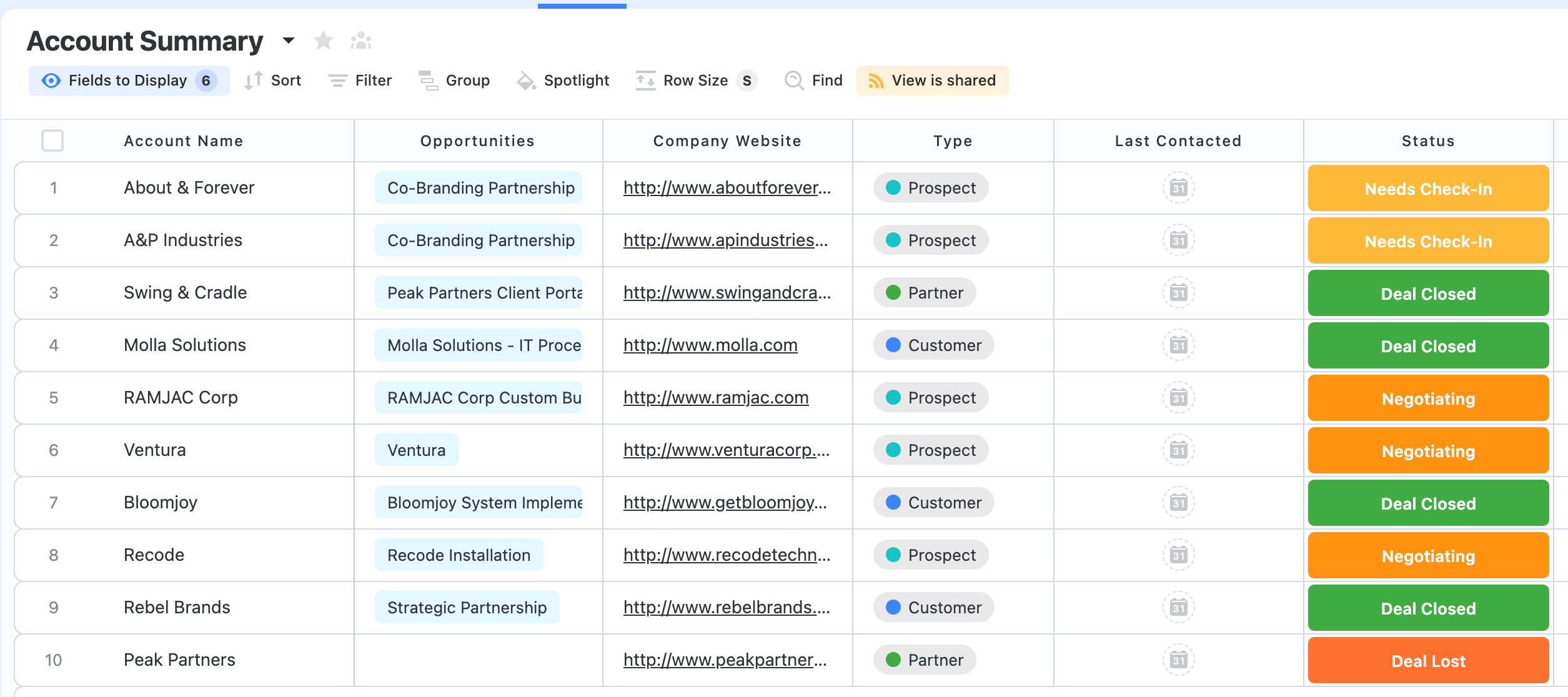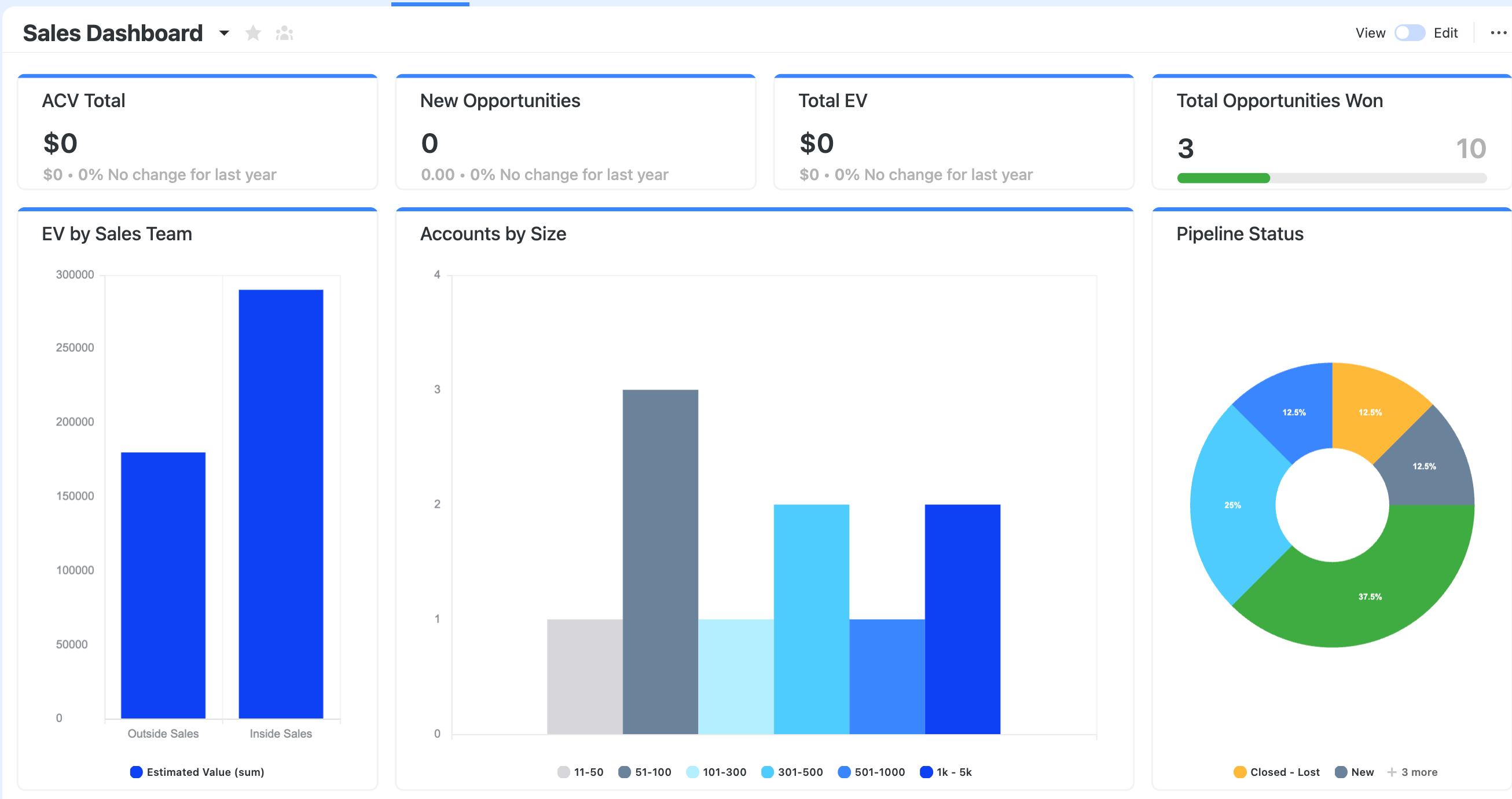
SmartSuite offers an adaptable solution for creating a Customer Relationship Management (CRM) system that caters to various business needs.
Whether you're managing customer relationships, tracking sales pipelines, or navigating the complexities of startup fundraising, SmartSuite can be tailored to meet your specific requirements.
This guide will walk you through setting up a CRM in SmartSuite and enhancing it with Relay's automation and AI capabilities to transform it into a dynamic tool for growth. Let's dive in.
Why use SmartSuite as a CRM?
Here are some reasons why SmartSuite could be the ideal platform for your CRM needs:
- Customization. SmartSuite allows for deep customization, enabling you to tailor your CRM to fit the exact specifications of your business operations. With a wide array of field types and layout options, you can design a system that mirrors your workflows, ensuring that your CRM evolves alongside your business.
- Collaboration features. Collaboration is at the heart of SmartSuite, facilitating seamless teamwork within your CRM. With real-time updates and shared access, teams can work together efficiently, ensuring everyone is aligned on customer management strategies and tasks.
- Powerful automation capabilities. SmartSuite offers built-in automation features that can significantly reduce manual work, from data entry to follow-up reminders. When paired with Relay, these capabilities expand to include AI-driven insights and personalized outreach, streamlining your operations and enriching customer interactions.
- Comprehensive integration options: The ability to integrate with a wide range of other tools and services, including email platforms, social media, and specialized automation tools like Relay, makes SmartSuite a versatile hub for all your CRM activities. This connectivity ensures that your CRM can easily fit within your existing tech ecosystem, enhancing functionality and efficiency.
- Scalability: As your business grows, so do your CRM needs. SmartSuite's scalable platform supports businesses at every stage of growth, from startups to established enterprises. Whether you're expanding your customer base, entering new markets, or scaling your operations, SmartSuite's CRM can adapt to meet your changing requirements.
How to build a SmartSuite CRM
Step 1. Select a template (or start from scratch)
Look, you can start from scratch, but why would you when SmartSuite provides a wide range of templates suitable for different CRM purposes? The templates offer a head start with pre-defined structures and fields, which you can customize to better suit your business processes.
Once you’ve created an account, you can access the Template Gallery from the sidebar on the homepage. Search “CRM” and you’ll find nine diverse templates ready to go—select the one that best fits your needs, and add it to your account (for this tutorial, we chose the default Sales CRM).

Step 2. Customize your CRM fields
So we have our barebones CRM populated with dummy data. If you find a template that closely aligns with your use case then you won’t have too much editing to do. If not, you’ll want to dedicate a bit of time to properly defining the fields you’ll need, such as contact details, interaction logs, project stages, and any other nuances of your particular industry.
For our example, we removed the HQ location, added a status field for a more granular look at the stage of the relationship, and also added a date field to track when the customer was last contacted.

Smartsuite provides an array of excellent rich field options, from the basics like single select, text and currency, to project management fields like assignments, checklists, and dependencies, to advanced options like IP address, formulas and lookup fields. So don’t just rely on text fields—explore the tools at your disposal!
Don’t forget that SmartSuite can build connective databases similar to Airtable to better link data. For example, our Sales CRM is made up of the main accounts Database (above) with distinct databases for contacts, opportunities, and sales resources, all connected and interlinked.
Step 3. Import your existing data
Time to add your data. The chances are you have your contacts somewhere in the digital realm—a spreadsheet, an Airtable base, or a Notion database. Whatever the case, with SmartSuite importing data is smooth and hassle-free.
First, delete the dummy data by clicking on the Solution title at the top of the page. Once that’s done, head over to the three-dot icon on the right of the screen, click Import, and select from the options.

Step 4. Configure custom views
SmartSuite's ability to create custom views is where its true power as a CRM platform shines, allowing you to visualize and manage your data in ways that are most meaningful to your business. By configuring custom views, you can tailor your CRM to reflect different aspects of your customer relationship management process.
- Kanban view allows you to drag and drop records as they move from one stage to the next
- Calendar view ensures you never miss an important date.
- Table view offers a detailed and customizable overview of all your data
- Gallery view provides a snapshot of important details at a glance
- Map view allows you to place each customer on a detailed world map
- Dashboard view provides a deep dive into your customer relationships and sales pipeline

These tailored views ensure that you and any team member can access the information they need in a format that supports their workflow—whether it's overseeing the entire sales pipeline or focusing on upcoming tasks.
Level up your SmartSuite CRM with Relay
Integrating Relay with your SmartSuite CRM isn't just about bringing automation into your customer relationship management; it's about transforming your CRM into a powerhouse of efficiency, insights, and personalized engagement.
Here's how Relay's key features align perfectly with the demands of a dynamic CRM system built on SmartSuite:
Automated Data Entry
Relay excels in capturing data where it happens. Whether it's a form submission via popular form tools, an email in Gmail, or a scheduling event in Calendly, Relay ensures this crucial data doesn't just sit in silos. Instead, it automatically populates your SmartSuite CRM, ensuring your database is always rich, up-to-date, and actionable.
Interaction tracking
The backbone of any effective CRM is a comprehensive log of interactions. Relay takes the heavy lifting out of logging emails, calls, and meetings by automating this process. Every interaction is meticulously recorded in SmartSuite, offering a 360-degree view of client engagements. This level of detail is invaluable for personalizing follow-ups and understanding client needs.
Personalized outreach
Relay's Paths feature enables you to tailor your outreach and follow-up processes based on specific customer actions or profiles. This means you can automate different communication strategies for different segments of your audience, ensuring each message is as relevant and engaging as possible.
And with our 'Human in the Loop' capability, you can add a layer of human judgment in your automations—whether it's approving communications, adding context to interactions, or making critical decisions. This feature ensures that your CRM isn't just automated but also intelligently guided by your team's insights.
Team coordination
With Relay, you can define roles within your automations to ensure that Sales, Customer Success, and Support teams are always in sync. Whether it's updating a CRM entry, kicking off an onboarding task, or sending internal updates over Slack, Relay ensures that the right people are informed and engaged at every step.
Creating and managing documents
Relay streamlines the creation of essential documents, from briefing docs and mutual action plans to contracts and invoices. By automating these tasks within your SmartSuite CRM (say, by automatically creating a summary document, and appending it to each new entry) Relay not only saves time but also ensures that your CRM is personalized and aligned with the needs of your clients or projects.
Over to you
With SmartSuite, you can build a CRM that streamlines your admin tasks and improves your ability to meaningfully engage with customers. Add Relay to that equation, and your SmartSuite CRM becomes a proactive, automated tool that supports your business objectives—whether you’re managing clients, tracking sales, or spearheading fundraising efforts.
What are you waiting for? Build a SmartSuite CRM, then try out Relay and see what you can do. Get started for free today.










